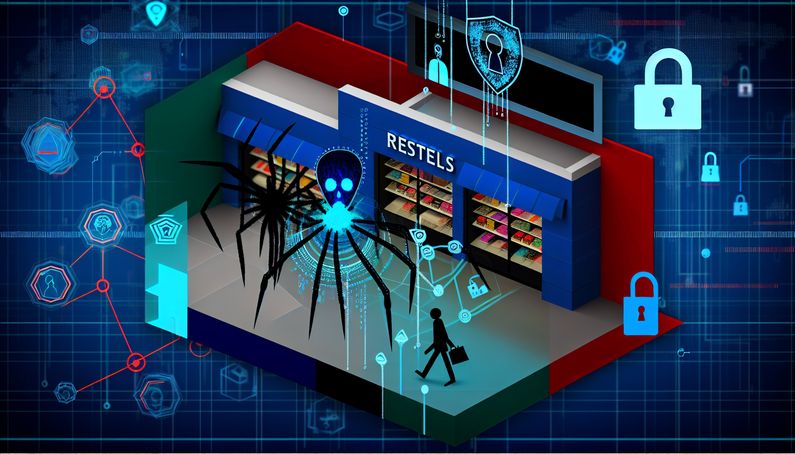
Marks & Spencer Cyberattack: A Comprehensive Analysis
The recent cyberattack on Marks & Spencer (M&S) serves as a stark reminder of the vulnerabilities that even well-established companies face in the digital age. This attack, orchestrated by affiliates of the DragonForce ransomware group, utilized sophisticated social engineering tactics known as Scattered Spider to infiltrate M&S’s network. The attackers targeted the company’s virtual machines, crippling its IT infrastructure and halting online sales, which are crucial for M&S’s revenue stream. The timing of the attack, coinciding with the Easter Bank Holiday, exacerbated its impact, leading to significant financial losses and operational disruptions. For more details on the attack methodology, see BleepingComputer.
Marks & Spencer Cyberattack: Details and Execution
Attack Methodology
The cyberattack on Marks & Spencer (M&S) was executed using ransomware, specifically targeting the company’s virtual machines. The attackers, identified as affiliates of the DragonForce ransomware group, utilized social engineering tactics known as Scattered Spider to breach M&S’s network. This method involved manipulating individuals to gain unauthorized access to sensitive systems. The attackers successfully encrypted VMware ESXi virtual machines hosted on M&S’s servers, which are critical for the company’s IT infrastructure. This encryption effectively paralyzed M&S’s ability to conduct business operations, particularly affecting their online sales platform. (BleepingComputer)
Impact on Operations
The ransomware attack had a profound impact on M&S’s operations. The company was forced to halt online orders, which account for a significant portion of its daily revenue, estimated at £3.8 million. The disruption extended beyond online sales, affecting contactless payments and click-and-collect services. This operational paralysis was exacerbated by the timing of the attack, which coincided with the Easter Bank Holiday, a peak period for retail activity. As a result, M&S faced significant financial losses, with estimates suggesting a weekly loss of £40 million due to the attack. (The Guardian)
Financial Repercussions
The financial repercussions of the cyberattack on M&S were severe. The company’s market value plummeted by over £700 million in the aftermath of the incident. This decline was driven by investor concerns over the prolonged disruption to M&S’s operations and the potential long-term impact on its reputation. Additionally, the company faced direct financial losses from the suspension of online sales and the costs associated with mitigating the attack and restoring its systems. These financial challenges were compounded by the uncertainty surrounding the timeline for full recovery, which further eroded investor confidence. (The Grocer)
Data Compromise
During the cyberattack, some customer data was compromised. M&S confirmed that personal data, including contact details and dates of birth, may have been accessed by the attackers. However, the company stated that there was no evidence of this data being shared or sold. Importantly, M&S assured customers that no card or payment details nor account passwords were compromised during the attack. This assurance was critical in maintaining customer trust and mitigating the potential reputational damage from the data breach. (The New York Times)
Response and Recovery Efforts
In response to the cyberattack, M&S implemented several measures to protect its customers and business operations. The company forced password resets for affected accounts and worked with leading cybersecurity experts to contain the breach and restore its systems. Despite these efforts, the recovery process was complex and time-consuming, with online sales remaining suspended for weeks. M&S’s response highlighted the challenges of managing a cyber incident of this scale, particularly in balancing the need for security with the urgency of restoring normal operations. The company’s experience underscores the importance of robust cybersecurity measures and incident response plans in mitigating the impact of such attacks. (TechCrunch)
Broader Implications
The cyberattack on M&S is indicative of a broader trend of increasing cyber threats targeting large retail organizations. The involvement of the Scattered Spider group, known for targeting high-profile companies, highlights the sophistication and persistence of modern cybercriminals. This incident serves as a stark reminder of the vulnerabilities inherent in digital infrastructures and the need for continuous vigilance and investment in cybersecurity. The attack also raises questions about the adequacy of existing security protocols and the need for enhanced collaboration between companies and cybersecurity experts to effectively combat such threats. (Al Jazeera)
Lessons Learned
The M&S cyberattack offers several lessons for other organizations in terms of preparedness and response to cyber threats. First, it underscores the importance of regular security audits and vulnerability assessments to identify and address potential weaknesses in IT systems. Second, it highlights the need for comprehensive incident response plans that include clear communication strategies to manage customer and stakeholder expectations during a crisis. Finally, the attack demonstrates the value of investing in employee training to reduce the risk of social engineering attacks, which remain a common entry point for cybercriminals. By learning from M&S’s experience, other organizations can strengthen their defenses and improve their resilience against future cyber threats. (BBC)
Final Thoughts
The Marks & Spencer cyberattack underscores the critical need for robust cybersecurity measures and proactive incident response strategies. As cyber threats continue to evolve, organizations must prioritize regular security audits and employee training to mitigate risks. The incident also highlights the importance of clear communication strategies during crises to maintain customer trust and manage stakeholder expectations. By learning from M&S’s experience, other companies can enhance their resilience against future cyber threats. For further insights into the broader implications of such attacks, refer to Al Jazeera.
References
- BleepingComputer. (2025). M&S says customer data stolen in cyberattack, forces password resets. https://www.bleepingcomputer.com/news/security/mands-says-customer-data-stolen-in-cyberattack-forces-password-resets/
- The Guardian. (2025). M&S cyber attack linked to hacking group Scattered Spider. https://www.theguardian.com/business/2025/apr/29/m-and-s-cyber-attack-linked-to-hacking-group-scattered-spider
- The Grocer. (2025). Marks and Spencer cyberattack: The reasons, damage, and lessons. https://www.thegrocer.co.uk/analysis-and-features/marks-and-spencer-cyberattack-the-reasons-damage-and-lessons/704050.article
- The New York Times. (2025). Marks & Spencer cyber attack. https://www.nytimes.com/2025/05/13/world/europe/marks-spencer-cyber-attack.html
- TechCrunch. (2025). Marks & Spencer confirms cybersecurity incident amid ongoing disruption. https://techcrunch.com/2025/04/22/marks-spencer-confirms-cybersecurity-incident-amid-ongoing-disruption/
- Al Jazeera. (2025). Harrods, M&S hit by cyberattack: What happened, who’s behind it. https://www.aljazeera.com/news/2025/5/2/harrods-ms-hit-by-cyberattack-what-happened-whos-behind-it
- BBC. (2025). Marks & Spencer cyberattack: Lessons learned. https://www.bbc.com/news/articles/cdxnkg7rln2o



